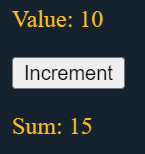Methods vs Computed in Vue
Last Updated :
22 Apr, 2024
Vue.js, with its simplicity and flexibility, has become a popular choice for building dynamic web applications. Among its many features, Vue provides two main ways to perform data manipulation and calculations within components: methods and computed properties. While they might seem similar at first glance, understanding the differences between them is crucial for effectively managing your Vue applications.
What are Methods?
Methods in Vue.js are simple JavaScript functions defined within the methods object of a Vue component. They are called directly from the template or within other methods using this keyword. Methods are suitable for performing actions, such as event handling, form submissions, or any other imperative logic.
Syntax:
export default {
data() {
return {
// data properties
};
},
methods: {
methodName() {
// method logic
}
}
}Example: The below code implements Vue methods to create a counter.
JavaScript
<!-- App.vue file -->
<template>
<div>
<p>Value: {{ value }}</p>
<button @click="increment">
Increment
</button>
<p>
Sum (Value+5):
{{ calculateSum() }}
</p>
</div>
</template>
<script>
export default {
data() {
return {
value: 10
};
},
methods: {
increment() {
this.value++;
},
calculateSum() {
return this.value + 5;
}
}
}
</script>
Output:

Benefits of Using Methods
- Methods provide a clear and explicit way to define behavior within Vue components.
- They are reusable and can be called from multiple places within the component.
- Methods can accept parameters, allowing for dynamic behavior based on input.
What are Computed Properties?
Computed properties in Vue.js are functions that are defined within the computed object of a Vue component. They are reactive and automatically re-evaluate whenever their dependent data properties change. Computed properties are suitable for deriving and caching computed values based on reactive data.
Syntax:
export default {
data() {
return {
// data properties
};
},
computed: {
propertyName() {
// computed property logic
}
}
}Example: The below code will explain the practical implementation of the computed properties in Vue.js.
JavaScript
<template>
<div>
<p>
Counter: {{ counter }}
</p>
<p>
Double Counter:
{{ doubleCounter }}
</p>
</div>
</template>
<script>
export default {
data() {
return {
counter: 2
};
},
computed: {
doubleCounter() {
return this.counter * 2;
}
}
}
</script>
Output:

Benefits of Using Computed Properties
- Computed properties offer a clean and concise way to derive values from existing data.
- They automatically cache their result and only re-compute when their dependencies change, improving performance.
- Computed properties promote code readability and maintainability by separating derived data from other logic.
Use cases of each one of them
Methods:
- Event handling: Methods are commonly used to handle user interactions, such as button clicks or form submissions.
- Data transformations: Methods are suitable for performing complex data transformations or calculations.
- Asynchronous operations: Methods can handle asynchronous tasks, such as fetching data from an API or performing network requests.
Computed Properties:
- Derived data: Computed properties are perfect for computing derived values from existing data, such as totals, averages, or filtered lists.
- Conditional rendering: Computed properties can determine whether certain elements should be displayed based on conditions.
- Caching expensive operations: Computed properties are useful for caching expensive computations to improve performance.
Which is Better to Use: Methods or Computed Properties and Why?
The choice between methods and computed properties depends on the specific use case.
- Use methods when you need to perform imperative actions or complex logic that doesn’t depend on reactive data changes.
- Use computed properties when you need to derive values from reactive data and want to benefit from Vue’s reactivity system and caching mechanism.
Differences between Methods and Computed Properties
Aspect
| Methods
| Computed Properties
|
|---|
Invocation
| Called explicitly from the template or within other methods.
| Automatically re-evaluated based on reactive dependencies.
|
|---|
Reactive
| Not reactive; execute when called.
| Reactive; recompute when dependent data changes.
|
|---|
Caching
| Results not cached; execute each time method is called.
| Automatically cache results and recompute only when dependencies change.
|
|---|
Use Case
| Suitable for imperative actions and complex logic.
| Ideal for deriving values from reactive data.
|
|---|
Performance
| May lead to unnecessary re-renders if not optimized.
| Optimized for performance with caching mechanism.
|
|---|
Share your thoughts in the comments
Please Login to comment...